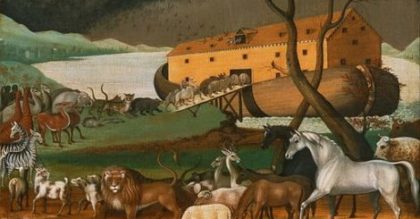
The Vertebrate Genomes Project caused a stir this week by publishing genomes of 15 species as a way of announcing a more ambitious plan of sequencing the genomes of all 66,000 living vertebrate species. That covers most of what might first come to mind when naming animals–dogs and cats and chickens and pigs and sheep and monkeys and tigers and sharks–basically most of what you might see at a zoo or on a farm. At the same time, it is a tiny and nonrepresentative fraction (>1%) of the estimated 8.7 million species on Earth, the majority of which are invertebrate animals. (And that number doesn’t include any bacteria or viruses.) Putting aside the questions of scientific and funding priorities that raises, I was particularly interested in how the metaphor of Noah’s ark showed up in the discussion of this project, up to and including the announced-but-not-yet-live Genome Ark website for hosting the genomic data.
To be clear, preservation is not a stated goal of the project, which will only generate an archive of digital information rather than any biological samples. That data has substantial value for exploring many research questions, but bringing an organism to life requires additional biology and chemistry not stored in a DNA sequence and thus not captured by this project. Nevertheless, Noah’s ark is such a strong part of our imagination that any cataloging of animals is likely to invoke it. Especially in our current context of existential anxiety, stemming from concerns about climate, violence, war and anything else that might end our lives or our way of life. It is only natural for preservation instincts to kick in.
And so I find myself wondering what it would take to preserve vertebrate life, and to what end? For plants, we actually have a solution in the global seed vault, a storage facility in a remote location in Norway intended to provide some continuity of crops and other plants in the event of a massive catastrophe. We could potentially do something similar for vertebrates, storing fertilized embryos, but we can’t just plant them in the dirt if we need to restore them. There has been some progress in artificial wombs, with a successful test on lambs last year, but those lambs had developed further than the embryo stage before the test. It’s possible such technology and techniques could advance to the point that they could support complete development from a frozen embryo, but at this stage we can’t count on it.
There is also the question of what it would mean to restore animals preserved in some fashion after an extended period of time. Sure, if a number of species went extinct tomorrow and we tried to bring them back shortly thereafter, they’d probably do well. But what if we didn’t need our animal vault for another hundred years? Or a thousand years? Or what if whatever causes the extinction profoundly changes the environment? Will any of our preserved creatures be able to thrive in the new world?
And then I remember the challenge of even preserving digital backups. Archives set aside to not be used until there is an emergency face all sorts of problems and so have a reputation of failing precisely during those emergencies when they are most needed. This is perhaps best illustrated by the story of how Toy Story 2 was deleted from Pixar computers and none of the backups were usable; the film was only salvaged because a remote employee had a local working copy.
Yes, there are procedures one can follow to test backups, but on some level the most reliable preservation plan is not an inert archive but a living, active system. A system not unlike the actual world we live in. So perhaps instead of contingency plans and backups, we should act as if Earth is already our Ark and act accordingly. It may not be our only option, but within the limits of what we can presently control, it is our best one.
Andy has worn many hats in his life. He knows this is a dreadfully clichéd notion, but since it is also literally true he uses it anyway. Among his current metaphorical hats: husband of one wife, father of two teenagers, reader of science fiction and science fact, enthusiast of contemporary symphonic music, and chief science officer. Previous metaphorical hats include: comp bio postdoc, molecular biology grad student, InterVarsity chapter president (that one came with a literal hat), music store clerk, house painter, and mosquito trapper. Among his more unique literal hats: British bobby, captain’s hats (of varying levels of authenticity) of several specific vessels, a deerstalker from 221B Baker St, and a railroad engineer’s cap. His monthly Science in Review is drawn from his weekly Science Corner posts — Wednesdays, 8am (Eastern) on the Emerging Scholars Network Blog. His book Faith across the Multiverse is available from Hendrickson.

Leave a Reply